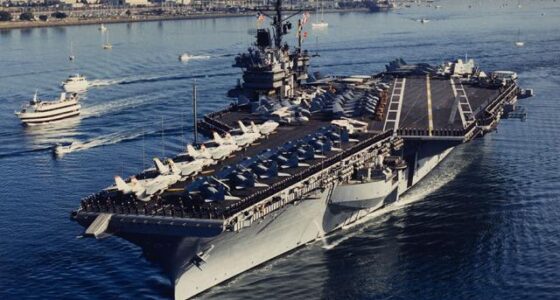The USS Ranger (CVA-61) was the third out of four Forrestal class supercarriers built for the U.S. Navy and the first built as an angled-deck ship from the start. Ordered in 1954 and launched in 1956 at a cost of $182 million, she largely operated in the Pacific Ocean, though she also served in the Indian Ocean and Persian Gulf at the end of her career. The Ranger had a distinguished service record, but the ship has been tied to numerous veterans being diagnosed with asbestos-related diseases, including malignant mesothelioma and lung cancer due to the presence of asbestos throughout its structure, equipment, and supplies.

About the USS Ranger
The USS Ranger (CVA-61) was one of four Forrestal-class aircraft carriers built for the U.S. Navy in the 1950s Named for James Forrestal, the first U.S. Secretary of Defense, the Forrestals were known for their enormous 75,000-ton size, which was 25% larger than the previous Midway class, as well as for being equipped with deck-edge elevators and angled decks capable of accommodating 80-to-100 jet aircraft. During her career, the Ranger participated in several notable firsts, including participating in the first joint operation that saw a Russian helicopter land on a Navy aircraft carrier and being the first Navy ship at sea to transmit digital photographs. The ship was also featured in Hollywood films, including Flight of the Intruder, Top Gun, and Star Trek IV: The Voyage Home.[1]
As the third Forrestal-class ship to be built, the Ranger has the distinction of having been the first to be built with an angled deck; the Forrestal and Saratoga were built earlier with axial decks that were converted to angled decks. The Ranger was also three feet longer than its sister ships and was the first of her class to operate in the Pacific. She was the tenth Navy ship to be named Ranger, which is why she is often referred to as Ranger X: the first Ranger was captained by John Paul Jones during the Revolutionary War.[1]
The Ranger and its sister ships were built amid America’s Cold War arms race with the Soviet Union. The ships represented significant advances in aircraft operations that continue to impact naval vessel design. Through nearly five decades of service, the carrier fulfilled multiple roles and set numerous records. She safeguarded vital maritime routes, projected American military power across various theaters of operation, and transported equipment and supplies for charitable organizations throughout the world, including medical supplies, clothing, and books.[1]
Construction of the USS Ranger
The USS Ranger was ordered by the U.S. Navy in February 1954, laid down in August 1954, and launched in September 1956. Built at the Newport News Shipbuilding yard in Newport News, Virginia, she was commissioned in August 1957 at the Norfolk Naval Shipyard. When fully loaded and manned, the USS Ranger displaced 81,101 long tons and carried a complement of 3,826 officers and men. She measured 1,071 feet long and was propelled by 8 Babcock & Wilcox boilers and 4 Westinghouse geared steam turbines. Her speed was 34 knots.[1]
The Ranger carried a complete of more than 100 fighters and bombers, the first of which was Attack Squadron 85, whose primary function was the delivery of atomic weapons at low altitude. By the time she was decommissioned 36 years later, she held a carrier record of nine combat deployments, had conducted 22 WestPac deployments, participated in operations in Vietnam, the Persian Gulf, and Somalia among other locations, and received multiple awards including three Navy United Commendations, five Meritorious Unit Commendations, three Battle “E” Awards, 12 Armed Forces Expeditionary Medals, and 25 Vietnam Service medals. She had carried more than 100,000 sailors and marines.[1]
Upgrades and Renovations
Over its operational lifespan, the Ranger underwent extensive modernization efforts, as well as repairs following numerous incidents, accidents, and fires. In 1963, she received a larger flight deck at the San Francisco Naval Shipyard, then returned in 1965 after a fuel line broke and ignited, engulfing her No. 1 main machinery room in flames. She received new firefighting equipment during an overhaul in late 1972 that facilitated bringing another shipboard fire under control, then underwent a complex 13-month overhaul in 1977 that significantly improved her military readiness and brought her up to modern standards. Another complex overhaul was conducted in Bremerton, Washington, in 1985.[1]
USS Ranger Service and Deployment History
The USS Ranger conducted extensive operations in the Western Pacific (WestPac) from the 1960s through the 1990s. In late 1962, she participated in Operation Pilot Light with USS Bon Homme Richard and Operation Handclasp, delivering humanitarian supplies to Hong Kong. The ship achieved several “firsts” in 1963, including conducting air operations with the USS Kitty Hawk at close range and catapulting a Phantom II while docked in Japan.
During the Vietnam War, the Ranger was heavily involved in combat operations, suffering multiple aircraft losses and crew casualties while conducting bombing missions and providing air support. Notable incidents included the capture and eventual escape of Lt. j.g. Dieter Dengler after being shot down over Laos in 1966. In the early 1970s, alleged internal sabotage attempts delayed deployments.
After the war in Vietnam concluded, Ranger continued regular WestPac deployments, responding to various challenges, including the 1979 Iran hostage crisis. The ship conducted numerous humanitarian missions, including rescuing Vietnamese refugees and Taiwanese fishermen.[1]
Throughout the 1980s, Ranger set records, including 121 consecutive days at sea in 1983-84. The ship served as a filming location for “Top Gun” and “Star Trek IV.” In 1983, a serious fire killed six sailors and injured 35 others, leading to difficult investigations and legal proceedings. She played a significant role in Operation Desert Storm in 1991, conducting over 4,200 sorties and dropping 4.2 million pounds of ordnance, and in her final WestPac deployment in 1992, she participated in Operation Southern Watch and Operation Restore Hope off Somalia, where the ship made history by conducting joint operations with Russian naval forces – a landmark sign of post-Cold War cooperation.[1]
Though Ranger was retained by the Navy for several years after being decommissioned in 1993, she was stricken from the Naval Vessel Register in 2004. A robust effort was made by the USS Ranger Foundation to have her turned into a floating museum on the Columbia River in Oregon, but the group was unable to raise sufficient funds. In 2014, she was sold for a single penny to International Shipbreaking Ltd., which broke her down and sold her materials for scrap.[2]
Was the USS Ranger Built Using Asbestos?
The USS Ranger, like other U.S. Navy vessels of its era, incorporated asbestos extensively throughout its construction. Asbestos was valued for its superior fire resistance and insulation capabilities, characteristics that were especially important to meet the robust fire prevention needs of aircraft carriers that carried so many expensive aircraft and large quantities of aviation fuel.
The ship’s power generation systems – particularly its turbines and boilers – relied heavily on asbestos insulation for its heat-resistant properties. Asbestos-based materials were used to wrap steam and hot water pipes, and special spray coatings containing asbestos provided both fireproofing and temperature control throughout the vessel.
The material’s presence extended to nearly every part of the ship. It was a component of critical safety equipment, including firefighting gear, protective clothing, and basic infrastructure. Integral parts such as pumps, gaskets, valves, flooring, ceiling materials, adhesives, deck matting, and even ropes contained asbestos.
The military chose asbestos for its cost-effectiveness, versatility, and perceived safety benefits. However, its widespread use – in hundreds of different ship components – would later prove problematic. It wasn’t until the 1980s that the severe health risks became fully understood, revealing dangers not only to the crew but also to shipyard workers involved in construction, maintenance, and overhauls and upgrades.
Who Was at Risk for Asbestos Exposure on the USS Ranger?
From the 1930s until it was discovered to be carcinogenic, the Department of Defense mandated the use of asbestos in hundreds of military applications. While the government’s intent was the protection of personnel and assets, asbestos ultimately caused widespread harm and tragedy. Veterans represent approximately one-third of all the malignant mesothelioma cases diagnosed in the United States and have been stricken by a significant portion of other asbestos-related illnesses.
USS Ranger crew members are among those most impacted by asbestos exposure, and the same is true of those who worked on the ship when she was in for overhauls and repairs. Regular shipboard activities, from everyday operations to maintenance work, could compromise asbestos-containing materials throughout the vessel. Even normal ship vibrations generated while sailing could damage these materials and make them release microscopic fibers into the air, and personnel were at even greater risk during the many fires and incidents that occurred over the years.
Sailors working in engine and boiler rooms were particularly vulnerable due to their confined workspaces, which combined notably poor ventilation with high concentrations of asbestos-laden equipment. Maintenance crews faced additional risks: Their duties often required them to access or repair pipes that were insulated with asbestos, releasing dangerous fibers into their immediate workspace.
Veterans from the USS Ranger Diagnosed with Asbestos Illnesses
There have been numerous asbestos-related personal injury lawsuits filed by Navy veterans who served on the USS Ranger, as well as claims filed by shipyard workers assigned to update and repair the vessel. In 1990, an eight-month investigation by the Naval Investigative Service confirmed what employees of a San Diego-based ship repair company had reported: The Ranger was filled with asbestos, including 260 feet of pipes covered with the carcinogenic material, and the workers and sailors onboard the ship had been exposed when California Marine Commercial Insulation Inc. and company president Frank Chavez knowingly failed to ensure their safety. Making matters worse, a memo showed that the Navy had been informed in January of problems aboard the vessel by the safety manager of another company that was working on the ship, who was concerned that sailors and his workers could be exposed to asbestos.[3]
Were You Diagnosed with Mesothelioma After Serving on the USS Ranger?
Navy veterans who served on the USS Ranger knew that their service put them at risk, but they never imagined it would lead to serious health consequences decades later. Shipboard asbestos exposure put them in danger of being diagnosed with asbestos-related illnesses, including malignant mesothelioma, asbestosis, and asbestos-related lung cancer. Many of these diseases have no cure, but veterans have several options for compensation, medical care, and emotional support.
The Department of Veterans Affairs provides comprehensive assistance to service members who have service-related illnesses, and malignant mesothelioma is classified as eligible for 100% reimbursement. Veterans diagnosed with the disease can take advantage of specialized healthcare at VA medical facilities, or they can choose to receive care at many of the dedicated cancer centers found across the United States. They are also eligible to receive disability compensation specifically for veterans affected by service-related asbestos exposure.
Though veterans cannot sue the military or government directly, they do have the right to pursue legal action against the manufacturers and suppliers who provided asbestos-containing materials to the Navy. Many of these companies were aware or should have been aware of the dangers posed by asbestos but kept the information quiet in order to continue earning profits. Over the years, veterans who have sued these companies have been awarded billions of dollars in compensation.
In addition to the physical disability, being diagnosed with an asbestos-related disease is an emotionally traumatic experience, and this is particularly true for veterans who were put at risk while serving their country. The best resource for learning about how to pursue justice is to seek guidance from a mesothelioma attorney who specializes in asbestos cases. These professionals possess unique expertise and extensive resources to help them identify the companies that supplied the asbestos you were exposed to while serving on the Ranger. They can guide you through your legal options, which include filing a personal injury lawsuit and claims against the asbestos trust funds set up by manufacturers and suppliers that were forced into bankruptcy by their asbestos liabilities. Time is critical, as legal statutes limit how long victims have to file lawsuits. Taking prompt action by consulting with an experienced asbestos attorney is your best first step.
References
- Naval History and Heritage Command. (N.D.). Ranger X (CVA-61.).
Retrieved from: https://www.history.navy.mil/research/histories/ship-histories/danfs/r/ranger-x.html - USNI News. (December 22, 2014.). Navy Pays Texas Ship Breaker a Penny to Dismantle Carrier Ranger.
Retrieved from: https://news.usni.org/2014/12/22/navy-pays-texas-ship-breaker-penny-dismantle-carrier-ranger - L.A. Times. (August 15, 1990.). Probe Faults Asbestos Cleanup of S.D. Ship.
Retrieved from: https://enewspaper.latimes.com/desktop/latimes/default.aspx?pubid=50435180-e58e-48b5-8e0c-236bf740270e

Terri Heimann Oppenheimer
WriterTerri Oppenheimer has been writing about mesothelioma and asbestos topics for over ten years. She has a degree in English from the College of William and Mary. Terri’s experience as the head writer of our Mesothelioma.net news blog gives her a wealth of knowledge which she brings to all Mesothelioma.net articles she authors.

Dave Foster
Page EditorDave has been a mesothelioma Patient Advocate for over 10 years. He consistently attends all major national and international mesothelioma meetings. In doing so, he is able to stay on top of the latest treatments, clinical trials, and research results. He also personally meets with mesothelioma patients and their families and connects them with the best medical specialists and legal representatives available.


